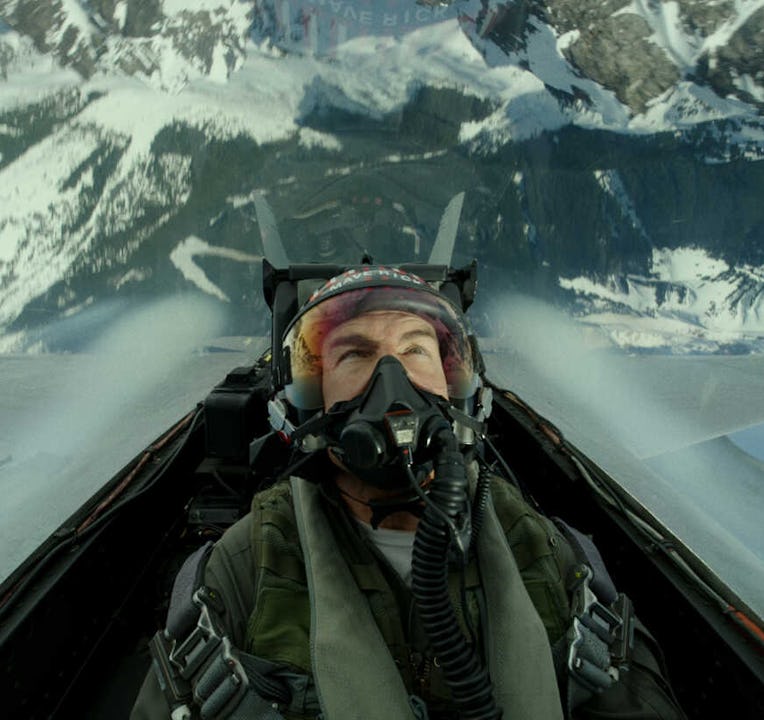'Top Gun: Maverick' Is All About Tom Cruise
'Maverick' is less a sequel to its predecessor than a tribute to its star

Any requel or reboot or revamp (whatever you want to call them these days) has to contend with the why. Why do we need to see a new version of a beloved property? Why would it make sense to revisit a story we were already told decades ago? The answer is usually just: Because it’s an easy way to make money. That is ostensibly why Top Gun: Maverick existed in its nascent stages, another in a long string of revived ‘80s properties meant to get people into the theaters because they know what to expect. The reason Top Gun: Maverick exists as it is now is because Tom Cruise needs all of us to know that he’s still got it, and that maybe he’s the only person alive who has anything at all. The result is thrilling.
Pete “Maverick” Mitchell (Cruise) is no longer the arrogant, cocksure twenty-something with a death wish we met in 1986’s original Top Gun. Now he’s a timeworn fifty-something who still flies like a maniac, but is insistent on everyone coming home alive.
After literally flying too close to the sun and destroying a multimillion dollar aircraft by taking it past its breaking point, Maverick is sent back to Top Gun, the elite school for the top one percent of Navy pilots. This time he’s there as a teacher — much to the chagrin of his new boss, Admiral Beau “Cyclone” Simpson (a very stern Jon Hamm) — and is tasked with getting a new group of young bucks ready to fly a seemingly impossible mission.
Among those pilots is Rooster (Miles Teller), the son of Maverick’s deceased best friend and flying partner Goose. The daddy issues that hover in the background of Top Gun are the focal point of its sequel, with Rooster blaming Maverick for his father’s death and Maverick feeling the need to be a surrogate father.
That’s not really what we care about though, is it? What we’re here to see is planes going fast. Luckily for us, they go really fast. The best parts of Tony Scott’s original movie all take place in the air, where we can be dazzled by the spectacle of flight. Joseph Kosinski’s sequel takes things one step further by pairing the balletic performance of dogfighting planes with close-ups of what someone’s face looks like when they approach 10 Gs.
Like Cruise’s best work in the Mission: Impossible series, Top Gun: Maverick is successful because what you are watching is real people actually risking their lives for your entertainment. It’s going to massively suck when this strategy of Cruise’s inevitably goes south one day, but today is not that day.
On the ground, Maverick has a requisite romantic subplot with the local bar owner Penny (Jennifer Connelly), whom he dated and left years ago. This part of the movie could almost be cut out entirely, but despite not having romantic chemistry with a woman on screen in nearly two decades, Cruise still insists on having a love interest. Besides, who else would Maverick have to unload his complicated emotions about Rooster if not a compassionate woman he just slept with? Luckily Connelly, who is contractually obligated to play some version of Crying Wife every three years, is up for the challenge.
Few people in Maverick’s life believe in his ability to do anything. He’s only at Top Gun in the first place because his old pal Iceman (Val Kilmer), now a four-star admiral, has spent seemingly decades keeping Maverick from being released. Everyone else thinks he’s an old bag of bones, and they are sure to mention that at any possible moment. At one point he is told that his kind is “headed for extinction.”
“Maybe so, sir, but not today,” Maverick responds, stating the thesis statement of the film. Maverick is less a sequel to its predecessor than a tribute to its star. Cruise at 59 years old is a better action star than he was at 24, buoyed by the technological advancements that allow you to feel like you’re sitting with him in the cockpit. Whatever he’s running on (adrenaline, fear, the power of Xenu), we’re on too.
Sure, there is nostalgia along the way. The film opens with basically a shot for shot remake of the original film’s opening, with planes landing on an aircraft carrier while synth music plays in the background. The iconic volleyball game meant to show animosity between two parties is now a team-building football game (they are still shirtless, and it is still hot). Like in the original, the American military looks sick as fuck while fighting their faceless foreign enemies (take your pick). There’s even an intentionally readable Lockheed Martin logo in one of Mav’s planes, in case you were unaware of who makes all of this possible.
But Top Gun: Maverick’s nods to the past serve to highlight that the present is faster, slicker, and more exciting. The handsome young cast of pilots (including a spectacularly well-cast Glenn Powell) inject some necessary new blood into the film, but no one steals the show entirely; how could they?
This is a movie about Tom Cruise. That much is made blatant in an electrifying, hold-your-breath sequence that requires Maverick to pilot an ancient F-14 in order to save the day. Do you get it? Cruise is the plane, and he’s still flying like he’s brand new.